Marvel Comics: First Half of 1998, Part 3
Marvel Team-Up vol 2 #1-11
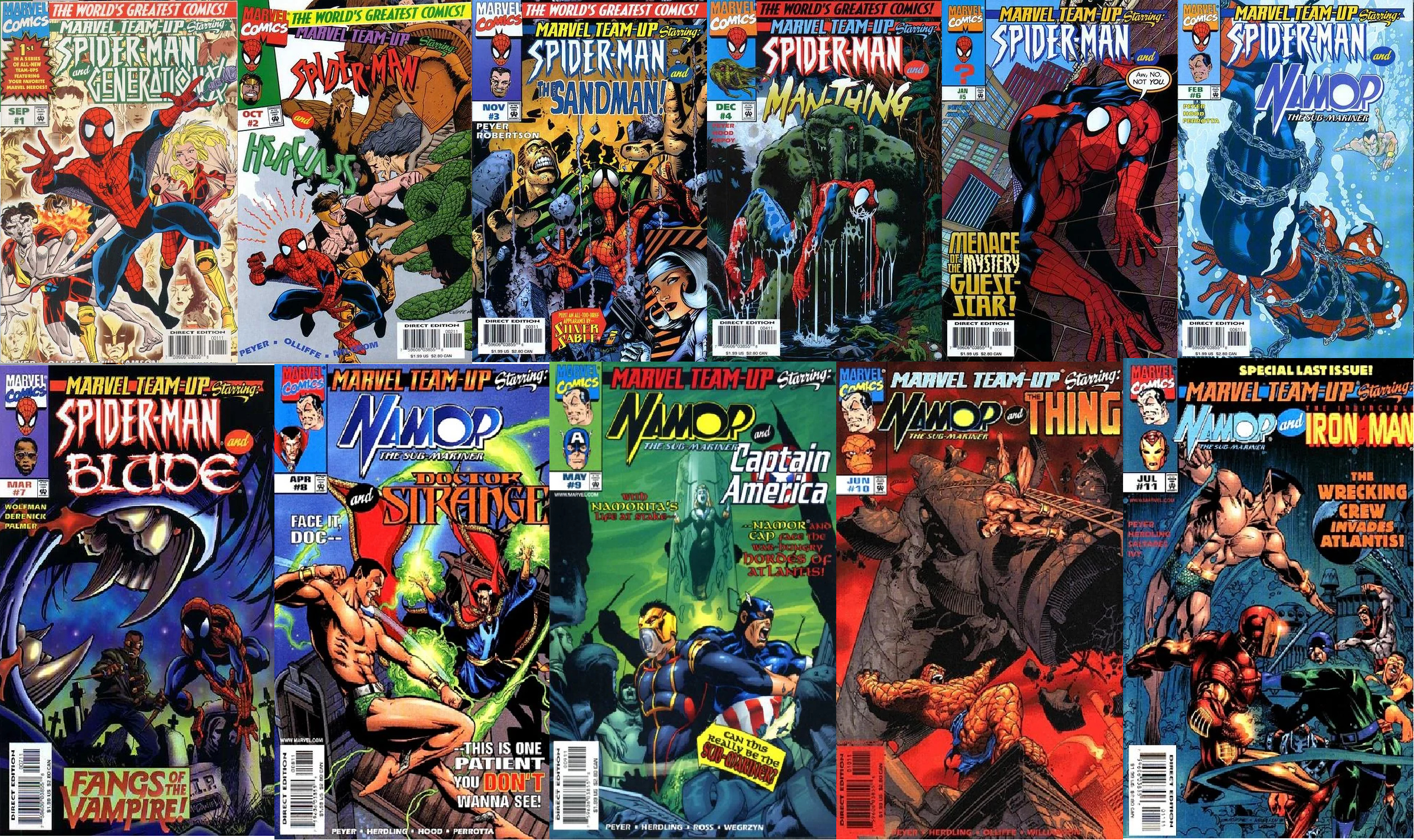
The first half of this short-lived title is a Spider-Man series that's solid at best. A supervillain called the Authority sends Spider-Man on a cross-country wild goose chase, battling various villains and teaming up with varous heroes. At the very end, he sends Spider-Man to go get a magical artifact, which of course he wants to use for nefarious purposes, so Spidey lets the artifact's original owner, the Watcher, have it back. It's fine.
Halfway thru the series, Namor returns from the Heroes Reborn/Return event, and after a Spider-Man/Namor crossover issue, Spider-Man disappears and the book becomes a Namor team-up book. This part of the series is far more interesting, cause Namor doesn't get his own series all that often. Over the course of four issues, Namor fights off attackers to Atlantis and reclaims the throne. And whereas for the Spider-Man issues, Spidey teamed up with different characters because he was in a different country every month, in the Namor issues the second team-up character keeps changing because nobody can stand to be around him longer than a single issue. I liked having him around, though. Give us more Namor titles, Marvel!
Marvel Universe #1-3
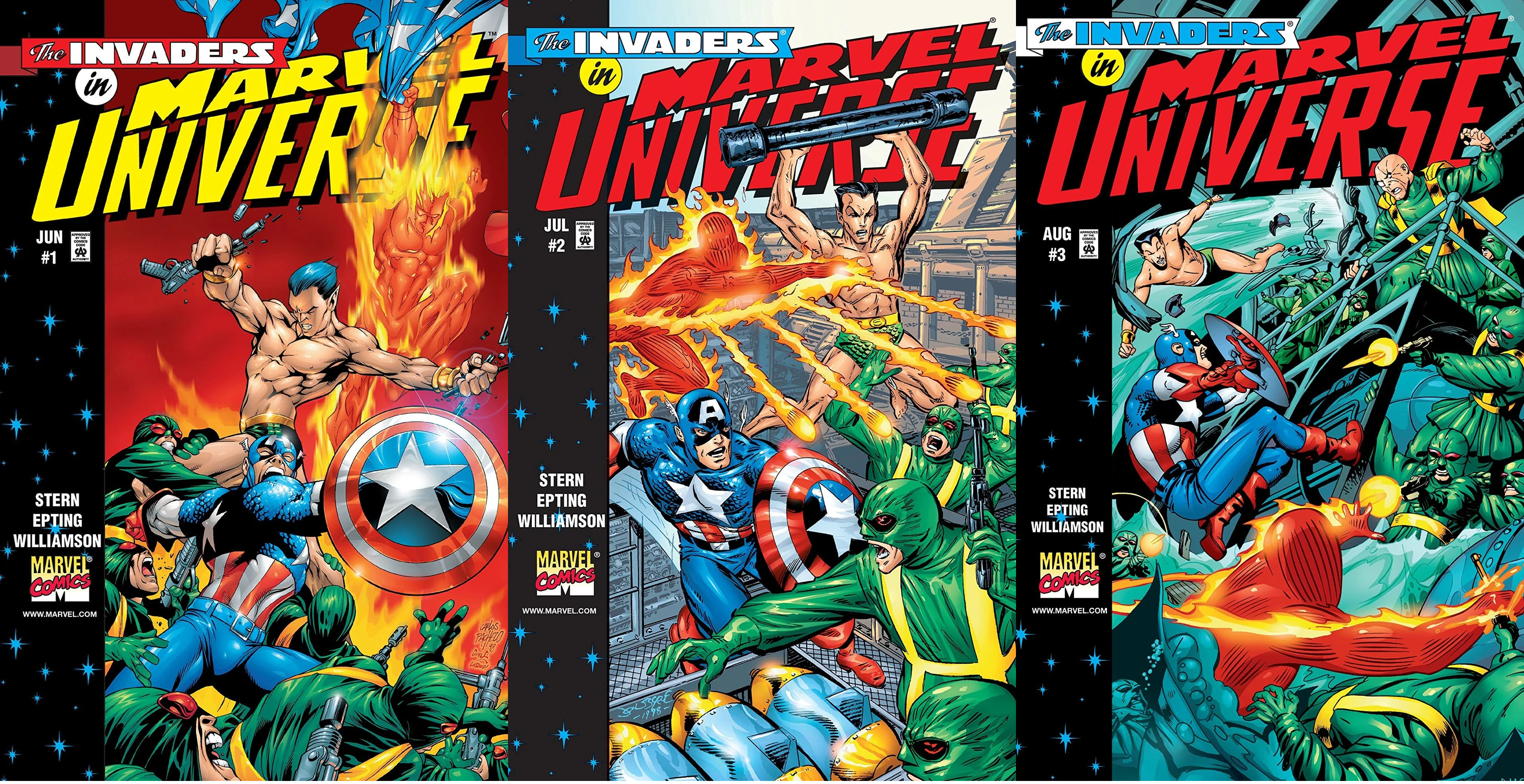
Somebody at Marvel decided it'd be a good idea to do an anthology title with stories from various settings and time periods in the Marvel Universe. On its own, that's not a particularly bad idea. But the first three-issue arc has been dreadful.
Besides the specific writing talents of Roger Stern, or lack thereof, I think two factors combined to make Marvel Universe an incredibly dull read. The first was the decision to stretch out each story into a several-issue multi-parter. It's not the only anthology title this year to do so - Journey Into Mystery took the same approach - but it hampers the book's stated ability to jump around and change subject very frequently.
The second poor choice was to start with a story about the Invaders, an Avengers-style team from the 1940s: Namor, Captain America, and an android Human Torch (predating the Human Torch of the Fantastic Four). I'm always up for more Namor, but at this point I feel like I've read stories about the Invaders SO many times.
It is kind of cool to see Steve Epting drawing this era here, a few years before he would be called on to draw WWII-era Marvel again for Brubaker's Captain America run in the mid 2000s. But the only new twist Roger Stern can think of for this story is that Baron Von Strucker got access to Doctor Doom's time machine, and uses it to Back-To-The-Future-Part-2 himself some atomic bombs. Come on.
Maverick vol 2 #1-12

I'm kind of perplexed as to why this series even exists. Here's Maverick, a guy wearing at least three times as much garishly-colored armor as is necessary, clearly a relic of the grim and gritty mid-90s that's mostly been abandoned by 1998, and Marvel's given him an entire ongoing series of his own. They don't really care about this being friendly to new fans, either - this follows directly from his one-shot in 1997 and his single appearance in the short story compilation X-Men Unlimited, and the cover doesn't really give you an indication of what kind of hero he is. What gives?
This is exactly the sort of title I should hate, cause grim gritty superheroes and their angst get old REAL fast. But Maverick's plotline is fairly straightforward, and Jorge Gonzales' writing isn't overly wordy, so it's a reasonably breezy read.
The plot hook for this ongoing series is that cancer-afflicted mutant Maverick suddenly goes into remission and gains new superpowers, giving him a new lease on life. There's a multi-part backup story in which Maverick's young ward gets his own adventures, which is mystifying, because none of this series' characters are memorable at all. Most perplexing of all, though, is the ending. As with many new series, Maverick builds up to a climax in issue twelve, wherein all the main enemies are defeated. But at the end of the issue, Maverick finds himself stranded in a snowy mountain range with no visible hope of rescue.
This isn't Maverick's last-ever appearance in Marvel Comics - he'll be back in a few years as a regular cast member of Weapon X Vol 2 - but it is his last ongoing series, and presumably the last appearance of his supporting cast, with whom he gets no reconciliation after the bad guys are defeated. If you know it's gonna be your series finale, why not tie it up in a bow? I'm looking at you too, Elektra.
Moon Knight vol 3 #1-4

Here's another title way better than it has any right to be. Character creator Doug Moench is given a four-issue miniseries to resurrect Moon Knight since he was killed in his last adventures.
The fun part about Moon Knight is the series' questions about belief and identity. It's pretty unclear for most of the series what motivates Moon Knight - is he actually gifted with divine power, or is he deluded? Once he stops asking questions and starts believing in himself, none of that matters anymore.
I also like that Moon Knight has multiple personalities. This is sort of quietly a thing in a lot of superhero comics - are Bruce Wayne and Batman actually the same person, or are they two distinct personalities? - but in situations where a character explicitly has multiple personalities, they aren't usually written very well. Compare the heroic Moon Knight here to the villainous and murderous Typhoid Mary over in Deadpool, for example.
Moon Knight is one of the only series this year that made me want to go back and read his older series at some point. The character and the series are haunting and dreamlike and super story-rich, and I dug the fuck out of them.
Quicksilver #1-10
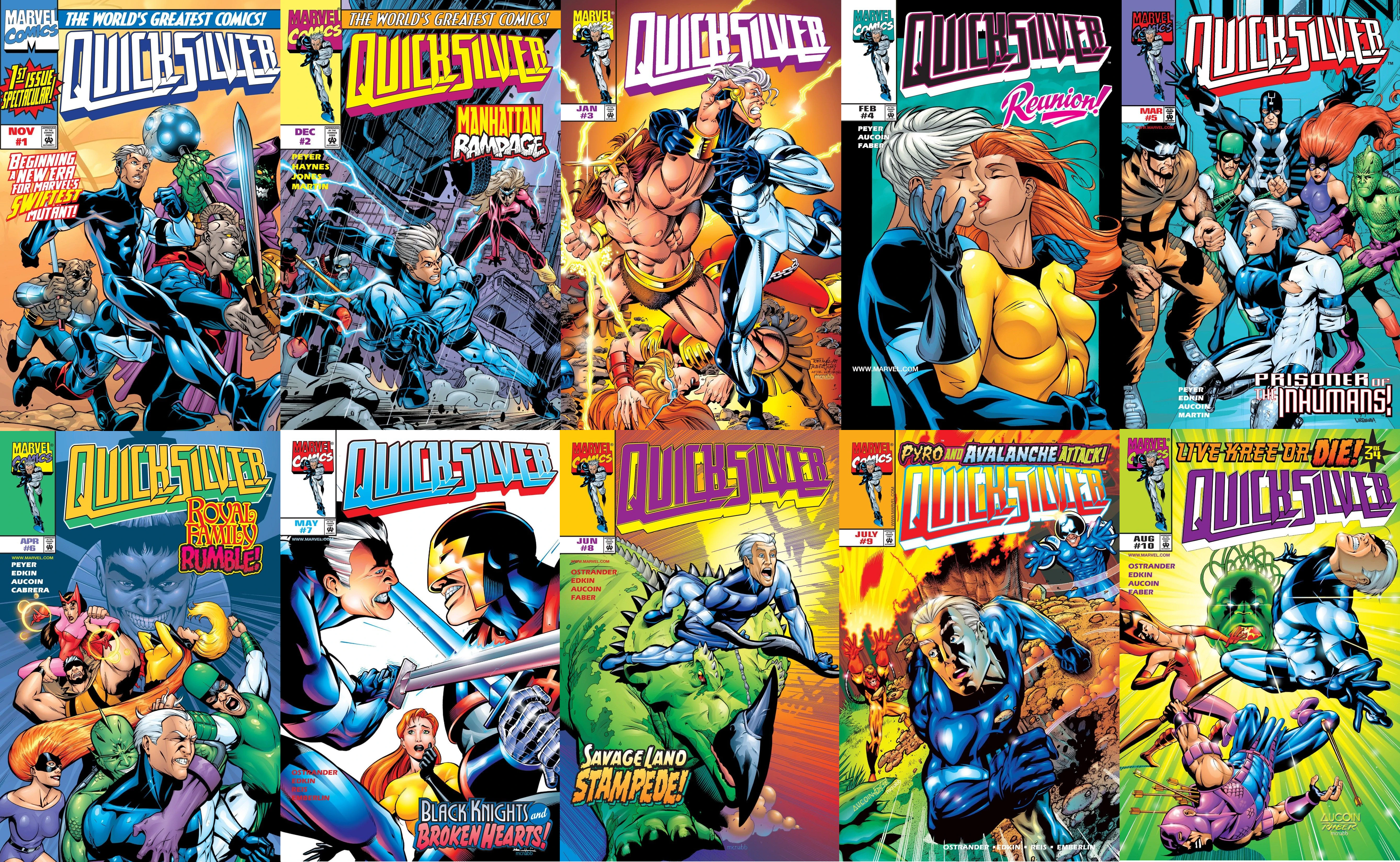
Quicksilver isn't the kind of mutant I generally give a shit about, and I certainly wasn't looking forward to reading an entire series devoted to him. But luckily the writers cram so much other interesting stuff into the comic that I didn't care that Pietro Maximoff is kinda dull.
In the very first issue, Quicksilver teams up with the Knights of Wundagore, a group of animals who have been evolved to a more anthropomorphized form and who are capable of speaking English. In other words, this ongoing Quicksilver series has a bunch of furries in it. And they're totally endearing! After this cast is spotlighted in the first few issues, they get their own subplots running thru the background of later issues. I loved them.
Only four issues in, Quicksilver's wife Crystal (hey look, it's another late 90s married superhero couple!) brings him to meet her Inhuman family at New Attilan on the moon. And this also is a lot of fun - the Inhumans have good visual design and some neat family drama. Also Crystal is just kind of a lovable character. Basically, anything in this series that didn't have much to do with Quicksilver, I loved, and there was quite a lot of that.
Rampaging Hulk vol 2 #1
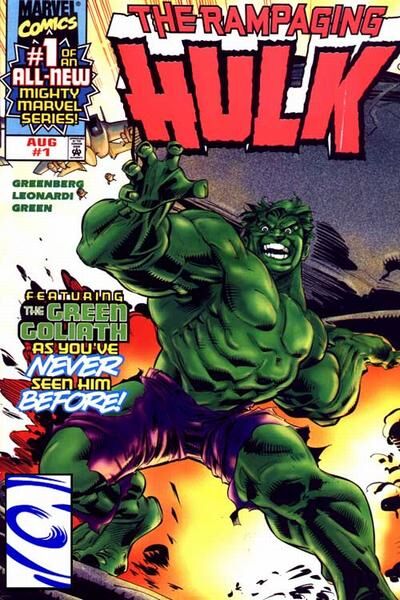
Here's a second Hulk series that Marvel apparently intended to be an ongoing series (although it only lasted for six issues). This issue takes place in the past, so it has nothing to do with current continuity, only reminding you of a time when things were simpler and General Ross & Hulk hated each other.
Seeker 3000 Premiere, #1-3

The spaceship on the cover of the Seeker 3000 comics looks a lot like the Enterprise from Star Trek, so I went in presuming this would be some new parody or ripoff of that story. It turned out to be something kind of different.
So back in the 1970s, Marvel had an anthology title called Marvel Premiere, which switched up its protagonist on a regular basis. After the release of Star Wars, Marvel looked for ways to cash in on audience appetite for stories in outer space. One of these attempts was Marvel Premiere #41, a self-contained story about a spaceship containing the last of the human race as they flee Earth and its dying sun. This is the issue reprinted in Seeker 3000 Premiere.
I almost didn't pick this series up, cause it's pretty hard to find. But one of the new series' writers is Dan Abnett, co-writer of a lot of contemporary Marvel cosmic stuff, including the modern reboot of the Guardians of the Galaxy.
I'm glad I found these issues, cause the writing in Seeker 3000 is good stuff. The plot involves various human and alien factions, but its complexity is contrasted with the ease and humanity with which Abnett writes dialogue. The first issue of the new series is quite long, but it blows by; the characters and their relationships are engaging.
Sensational Spider-Man #25-30

If you're reading all four Spider-Man books in 1998, Sensational is the first one to come out each month, so it kinda sets the tone for the rest of the month.
Most Spider-Man comics are about relationships - the character has a huge supporting cast, so his series tend to be even more soap opera-y than other Marvel comics. But I think the most unique thing I can say about Sensational is that it makes Spider-Man's relationships integral to the plot.
Here's a couple of examples. The identity that writer Todd Dezago comes up with for Identity Crisis is the Hornet, a Beetle-esque persona, and it's enabled via the Prowler's tech. Later on, Dezago's resolution to the Hornet's storyline comes when the Vulture fights him and recognizes that the Hornet is Spider-Man within about two minutes.
Silver Surfer vol 3 #135-142

Silver Surfer is J.M. DeMatteis' second project, along with Man-Thing. It's more accessible than Man-Thing, but still tackles some big ideas about the nature of existence thru a superheroic lens.
I started reading in the arc when Surfer dies and is subsequently brought back to life, though not without tussling with Mephisto. The next two Silver Surfer villains both want to allow humanity to ascend to a higher plane of existence, which basically means turning them into living energy. Surfer is tempted, and is thrown into the Macroverse, a beautifully-rendered plane of existence that allows him to surf across many universes all at once. It's kind of like if an indie director was suddenly given the reins to a blockbuster movie franchise like Star Wars, and it's breathtakingly beautiful at times.
Silver Surfer & Thor Annual 1998
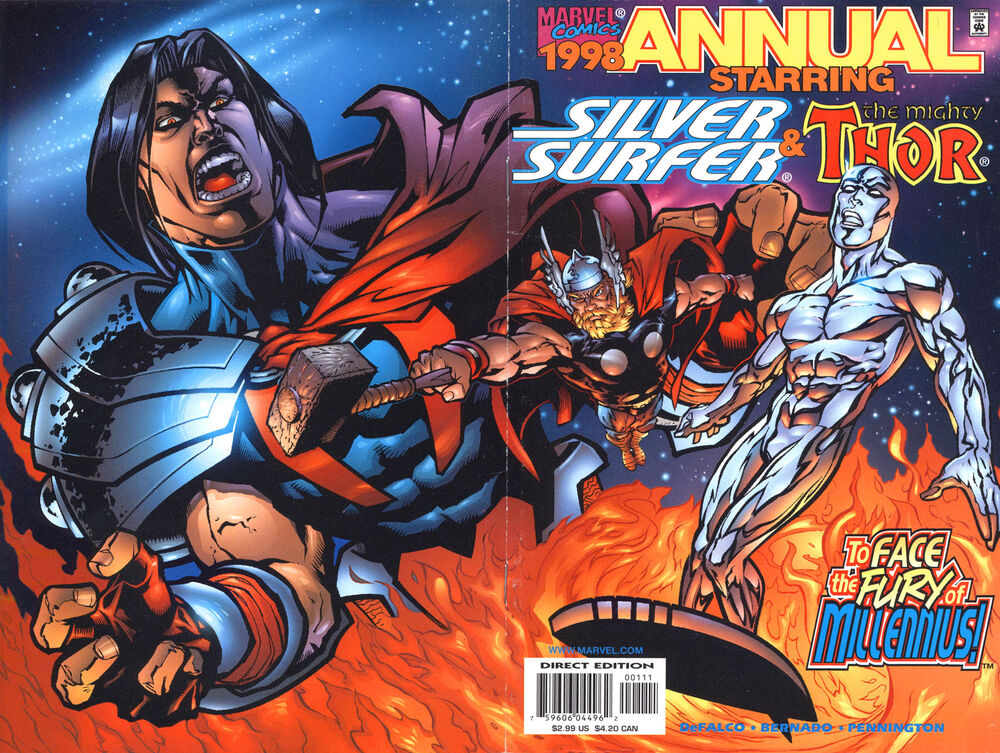
Rather than slot this annual into DeMatteis' main epic storyline, DeFalco pops in to write this one-off issue wherein Thor and Surfer team up against a cosmic villain. It's not bad.
Spectacular Spider-Man #255-260

In the aftermath of the Clone Saga, which wrapped up in 1997, the biggest unresolved plot thread is Norman Osborn, returned from the dead and not only having escaped justice for his crimes as the Green Goblin, but in a position of power as the owner of the Daily Bugle. Spectacular is the only Spider-title to really deal with this plot thread on a monthly basis. It also is the last Spider-title to come out every month, so it had to wrap up both the Spider-Hunt and Identity Crisis events.
Perhaps relatedly, Spectacular can't manage to keep a consistent writer on the title, at least in the stretch of issues I read. Tom DeFalco, J.M. DeMatteis, Glenn Greenberg, and Roger Stern all contribute to this stretch. It's easily the most uneven Spider-comic of the four (DeMatteis really has a completely different sensibility from the others), but it's still a totally engaging entry in the Spider-Man soap opera, and it's pretty exciting to see Norman Osborn getting potentially closer to his eventualy comeuppance.
Spider-Man #89-94

The adjectiveless Spider-Man title easily takes the most risks of any of the current Spider-Man titles. Howard Mackie's idea for a new identity is Dusk, a moniker that Spider-Man takes on while helping out a rebellion inside the Negative Zone. Dusk allies with supervillain Paste-Pot Pete, making Dusk the most (relatively) antiheroic of the four new Spider-identities.
Mackie also does a one-off story called "Who Was Joey Z?", which sees Spider-Man and Jill Stacy separately investigating the identity of a supervillain's henchman. There's also a really good issue starring Ghost Rider. And all of this is drawn by John Romita Jr., easily one of the best artists of Spider-Man and indeed in all of comics. If I had to pick a favorite of the four Spider-titles, it might be this one.
Spider-Man: Made Men #!
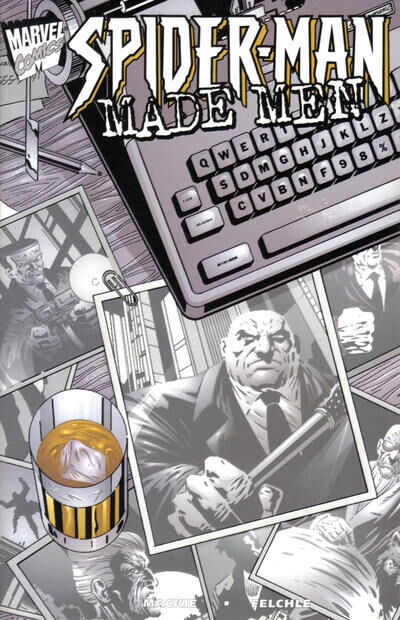
From the same writer as the adjectiveless Spider-Man title comes this oversized, occasionally-prose one shot about two brothers who find themselves under the employ of Wilson Fisk and the FBI respectively. It's a haunting tale about how the soap opera drama of superheroes and supervillains affects the people around them. Strong stuff.
Spider-Man Unlimited #20-21
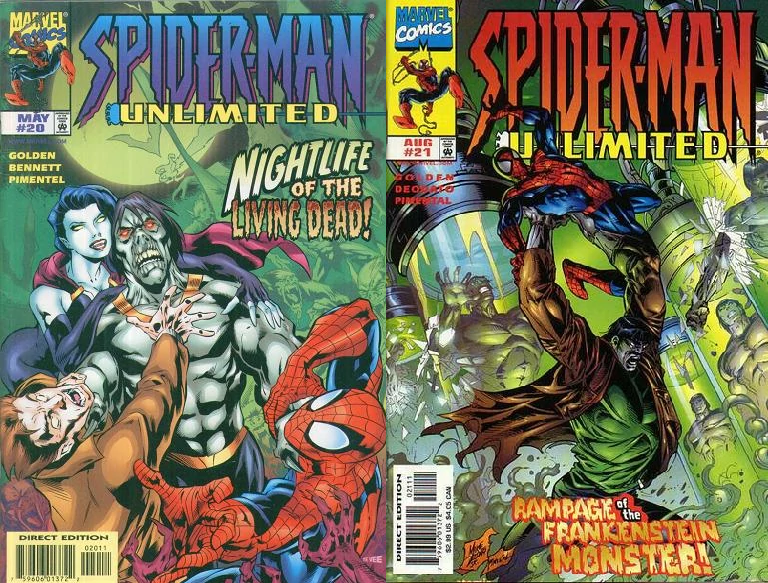
The "Unlimited" line, currently featuring this title and "X-Men Unlimited," is a place for writers to do one-off stories with the characters. These two issues are handled by writer Chris Golden, who takes the opportunity to pit Spider-Man against some classic horror movie monsters: a zombie and the daughter of Dracula in #20, and Frankenstein's monster in #21. For me, I preferred the second issue; sexy vampire girl was *just* edged out by Frankenstein's monster and his surprising humanity.
Strange Tales: Dark Corners #1

Here's a one-shot featuring stories of three characters who don't have their own title at the moment: Cloak & Dagger, Morbius, and Gargoyle.
From worst to best: the Morbius story is about a dozen pages of him spying on his ex-fiancee while she works. It is gross. The Gargoyle story is evocative, especially with its painterly art, and it was very nearly my favorite of the bunch. Unfortunately, there's not much point to the story except to set up an appearance in Silver Surfer.
So my favorite story in the issue ended up being Cloak & Dagger - perhaps predictable, since I have a soft spot for those two. But it's also the most competently written story - the heroes infiltrate and break up a gang preying on children and bring them to a foster home.
Thor vol 2 #1-2
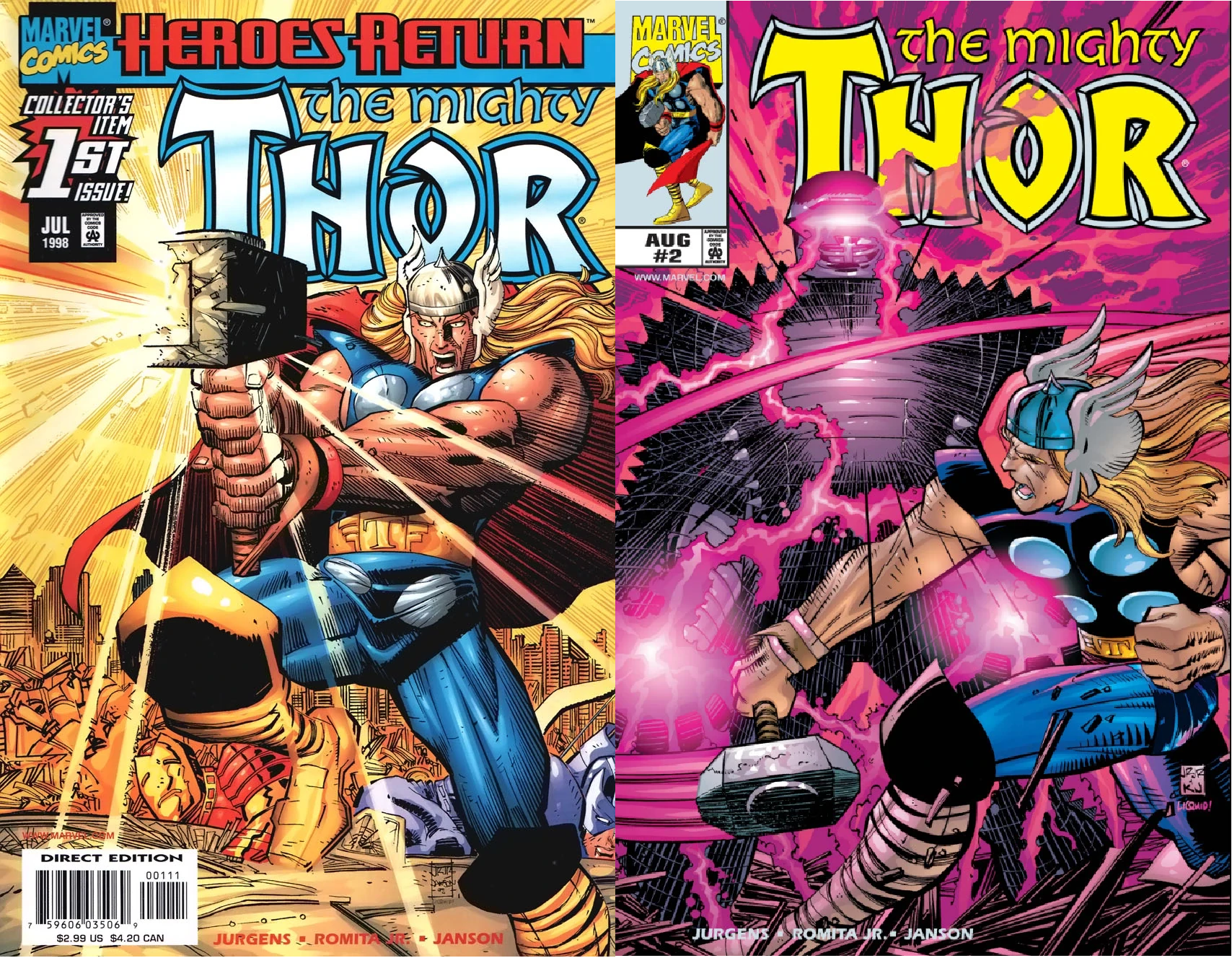
It's hard to tell how this title will turn out - so far it's a pretty solid Thor title and not much more. Dan Jurgens' big twist is to give Thor a new secret identity; in the first two issues, Thor dies and is sent to hell, and is brought back to life by merging with a recently deceased paramedic. Could be either really good or really frustrating.
Thunderbolts #1-17, Annual 1997


Here's the best-conceived and at times best-written series in 1998, I think. The hook is this: in the aftermath of Onslaught and the disappearance of major heroes like the Avengers and Fantastic Four, a new team of superheroes called the Thunderbolts appear and quickly come to prominence. These heroes are actually supervillains in disguise, under the direction of Baron Von Zemo. Their plan is to ingratiate themselves to the public just long enough to gain access to secret files only superheroes have access to, and use them to take over the world.
But here's the twist: in the process of pretending to be superheroes, many of the supervillains find out that they actually do want to reform and be better people. So the question of the book is, now that they've been given this chance, how many of them (if any) will be able to be the heroes they want to be deep down?
Busiek throws a LOT at these characters in the first twelve issues. They rescue and recruit a young superhero named Jolt who doesn't know that they're supervillains. (This provides the plot hook of the Annual - Baron Von Zemo tells Jolt her teammates' origins, but twists their stories to hide their true nature as villains in disguise.) Black Widow shows up and warns them to stay on the straight-and-narrow, having figured out they're actually villains. They fight off a supervillain team who took their old supervillain team name, the Masters of Evil, which tempts Zemo to reveal themselves.
And then, merely ten issues in, Zemo learns of discord within the group, and reveals the Thunderbolts' status as "reformed" villains to the world, forcing the team to stick by Zemo rather than be caught by the authorities. This plays into the publishing phenomenon I mentioned before where new series usually build to a climax by the end of the first year. By the end of issue twelve, the Thunderbolts have fought and then teamed up with the Avengers, broken free of Zemo's clutches, and gone on the run.
It's hard to say if the second year is as good as the first, yet. Now under the direction of Moonstone, the Thunderbolts have done some pretty shitty things, including destabilizing an entire planet in order to get back home to Earth. The tension now seems to be whether they can stick together under the manipulative direction of Moonstone, and whether they'll survive an impending conflict with Zemo. But I'm hooked. I love the characters and the premise, I think Busiek does more with this comic than he's doing anywhere else in 1998, and I'm excited to see this team continue on for a hundred more issues. To me, this is the best comic I've read for this project to date.